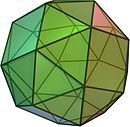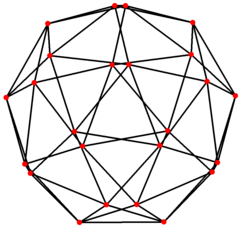Snub cube
This article includes a list of general references, but it lacks sufficient corresponding inline citations. (January 2012) |
This article or section is in a state of significant expansion or restructuring. You are welcome to assist in its construction by editing it as well. If this article or section has not been edited in several days, please remove this template. If you are the editor who added this template and you are actively editing, please be sure to replace this template with {{in use}} during the active editing session. Click on the link for template parameters to use.
This article was last edited by AnomieBOT (talk | contribs) 37 seconds ago. (Update timer) |
| Snub cube | |
|---|---|
  Two different forms of a snub cube | |
| Type | Archimedean solid |
| Faces | 38 |
| Edges | 60 |
| Vertices | 24 |
| Symmetry group | Rotational octahedral symmetry |
| Dihedral angle (degrees) | triangle-to-triangle: 153.23° triangle-to-square: 142.98° |
| Dual polyhedron | Pentagonal icositetrahedron |
| Properties | convex, chiral |
| Vertex figure | |
 | |
| Net | |
 | |

In geometry, the snub cube, or snub cuboctahedron, is an Archimedean solid with 38 faces: 6 squares and 32 equilateral triangles. It has 60 edges and 24 vertices.
Kepler first named it in Latin as cubus simus in 1619 in his Harmonices Mundi. H. S. M. Coxeter, noting it could be derived equally from the octahedron as the cube, called it snub cuboctahedron, with a vertical extended Schläfli symbol , and representing an alternation of a truncated cuboctahedron, which has Schläfli symbol .
Construction
The snub cube can be generated by taking the six faces of the cube, pulling them outward so they no longer touch, then giving them each a small rotation on their centers (all clockwise or all counter-clockwise) until the spaces between can be filled with equilateral triangles.[1]
The snub cube can also be derived from the truncated cuboctahedron by the process of alternation. 24 vertices of the truncated cuboctahedron form a polyhedron topologically equivalent to the snub cube; the other 24 form its mirror-image. The resulting polyhedron is vertex-transitive but not uniform.
Cartesian coordinates
Cartesian coordinates for the vertices of a snub cube are all the even permutations of
This snub cube has edges of length , a number which satisfies the equation
Properties
For a snub cube with edge length , its surface area and volume are:[3]
The snub cube is an Archimedean solid, meaning it is a highly symmetric and semi-regular polyhedron, and two or more different regular polygonal faces meet in a vertex.[4] It is chiral, meaning there are two distinct forms whenever being mirrored. Therefore, the snub cube has the rotational octahedral symmetry .[5][6] The polygonal faces that meet for every vertex are four equilateral triangles and one square, and the vertex figure of a snub cube is . The dual polyhedron of a snub cube is pentagonal icositetrahedron, a Catalan solid.[7][page needed]
Related polyhedra and tilings
The snub cube is one of a family of uniform polyhedra related to the cube and regular octahedron.
| Uniform octahedral polyhedra | ||||||||||
|---|---|---|---|---|---|---|---|---|---|---|
| Symmetry: [4,3], (*432) | [4,3]+ (432) |
[1+,4,3] = [3,3] (*332) |
[3+,4] (3*2) | |||||||
| {4,3} | t{4,3} | r{4,3} r{31,1} |
t{3,4} t{31,1} |
{3,4} {31,1} |
rr{4,3} s2{3,4} |
tr{4,3} | sr{4,3} | h{4,3} {3,3} |
h2{4,3} t{3,3} |
s{3,4} s{31,1} |
= |
= |
= |
||||||||
| Duals to uniform polyhedra | ||||||||||
| V43 | V3.82 | V(3.4)2 | V4.62 | V34 | V3.43 | V4.6.8 | V34.4 | V33 | V3.62 | V35 |
This semiregular polyhedron is a member of a sequence of snubbed polyhedra and tilings with vertex figure (3.3.3.3.n) and Coxeter–Dynkin diagram ![]()
![]()
![]()
![]()
![]() . These figures and their duals have (n32) rotational symmetry, being in the Euclidean plane for n = 6, and hyperbolic plane for any higher n. The series can be considered to begin with n=2, with one set of faces degenerated into digons.
. These figures and their duals have (n32) rotational symmetry, being in the Euclidean plane for n = 6, and hyperbolic plane for any higher n. The series can be considered to begin with n=2, with one set of faces degenerated into digons.
| n32 symmetry mutations of snub tilings: 3.3.3.3.n | ||||||||
|---|---|---|---|---|---|---|---|---|
| Symmetry n32 |
Spherical | Euclidean | Compact hyperbolic | Paracomp. | ||||
| 232 | 332 | 432 | 532 | 632 | 732 | 832 | ∞32 | |
| Snub figures |

|

|

|

|

|

|

|

|
| Config. | 3.3.3.3.2 | 3.3.3.3.3 | 3.3.3.3.4 | 3.3.3.3.5 | 3.3.3.3.6 | 3.3.3.3.7 | 3.3.3.3.8 | 3.3.3.3.∞ |
| Gyro figures |

|

|

|

|

|

|

|

|
| Config. | V3.3.3.3.2 | V3.3.3.3.3 | V3.3.3.3.4 | V3.3.3.3.5 | V3.3.3.3.6 | V3.3.3.3.7 | V3.3.3.3.8 | V3.3.3.3.∞ |
The snub cube is second in a series of snub polyhedra and tilings with vertex figure 3.3.4.3.n.
| 4n2 symmetry mutations of snub tilings: 3.3.4.3.n | ||||||||
|---|---|---|---|---|---|---|---|---|
| Symmetry 4n2 |
Spherical | Euclidean | Compact hyperbolic | Paracomp. | ||||
| 242 | 342 | 442 | 542 | 642 | 742 | 842 | ∞42 | |
| Snub figures |

|

|

|

|

|

|

|

|
| Config. | 3.3.4.3.2 | 3.3.4.3.3 | 3.3.4.3.4 | 3.3.4.3.5 | 3.3.4.3.6 | 3.3.4.3.7 | 3.3.4.3.8 | 3.3.4.3.∞ |
| Gyro figures |

|

|

|

|
||||
| Config. | V3.3.4.3.2 | V3.3.4.3.3 | V3.3.4.3.4 | V3.3.4.3.5 | V3.3.4.3.6 | V3.3.4.3.7 | V3.3.4.3.8 | V3.3.4.3.∞ |
Snub cubical graph
| Snub cubical graph | |
|---|---|
 4-fold symmetry | |
| Vertices | 24 |
| Edges | 60 |
| Automorphisms | 24 |
| Properties | Hamiltonian, regular |
| Table of graphs and parameters | |
In graph theory, a snub cubical graph is the graph of vertices and edges of the snub cube, one of the Archimedean solids. It has 24 vertices and 60 edges, and is an Archimedean graph.[8]

|
See also
References
- ^ Holme, A. (2010). Geometry: Our Cultural Heritage. Springer. doi:10.1007/978-3-642-14441-7. ISBN 978-3-642-14441-7.
- ^ Collins, Julian (2019). Numbers in Minutes. Hachette. p. 36–37.
- ^ Berman, Martin (1971). "Regular-faced convex polyhedra". Journal of the Franklin Institute. 291 (5): 329–352. doi:10.1016/0016-0032(71)90071-8. MR 0290245.
- ^ Diudea, M. V. (2018). Multi-shell Polyhedral Clusters. Springer. p. 39. doi:10.1007/978-3-319-64123-2. ISBN 978-3-319-64123-2.
- ^ Koca, M.; Koca, N. O. (2013). "Coxeter groups, quaternions, symmetries of polyhedra and 4D polytopes". Mathematical Physics: Proceedings of the 13th Regional Conference, Antalya, Turkey, 27–31 October 2010. World Scientific. p. 49.
- ^ Cromwell, Peter R. (1997). Polyhedra. Cambridge University Press. p. 386. ISBN 978-0-521-55432-9.
- ^ Williams, Robert (1979). The Geometrical Foundation of Natural Structure: A Source Book of Design. Dover Publications, Inc.
- ^ Read, R. C.; Wilson, R. J. (1998), An Atlas of Graphs, Oxford University Press, p. 269
- Jayatilake, Udaya (March 2005). "Calculations on face and vertex regular polyhedra". Mathematical Gazette. 89 (514): 76–81. doi:10.1017/S0025557200176818. S2CID 125675814.
- Williams, Robert (1979). The Geometrical Foundation of Natural Structure: A Source Book of Design. Dover Publications, Inc. ISBN 0-486-23729-X. (Section 3-9)
External links
- Weisstein, Eric W., "Snub cube" ("Archimedean solid") at MathWorld.
- Klitzing, Richard. "3D convex uniform polyhedra s3s4s - snic".
- The Uniform Polyhedra
- Virtual Reality Polyhedra The Encyclopedia of Polyhedra
- Editable printable net of a Snub Cube with interactive 3D view
- Articles with short description
- Short description is different from Wikidata
- Articles lacking in-text citations from January 2012
- All articles lacking in-text citations
- Pages actively undergoing construction
- Pages using multiple image with auto scaled images
- Wikipedia articles needing page number citations from June 2024
- Chiral polyhedra
- Uniform polyhedra
- Archimedean solids
- Snub tilings










![{\displaystyle {\begin{aligned}\alpha &={\sqrt {{\frac {4}{3}}-{\frac {16}{3\beta }}+{\frac {2\beta }{3}}}}\approx 1.609\,72\\\beta &={\sqrt[{3}]{26+6{\sqrt {33}}}}.\end{aligned}}}](https://wikimedia.org/api/rest_v1/media/math/render/svg/dcce93203241f81fe890e5c1ab8cdd80476937e8)

















